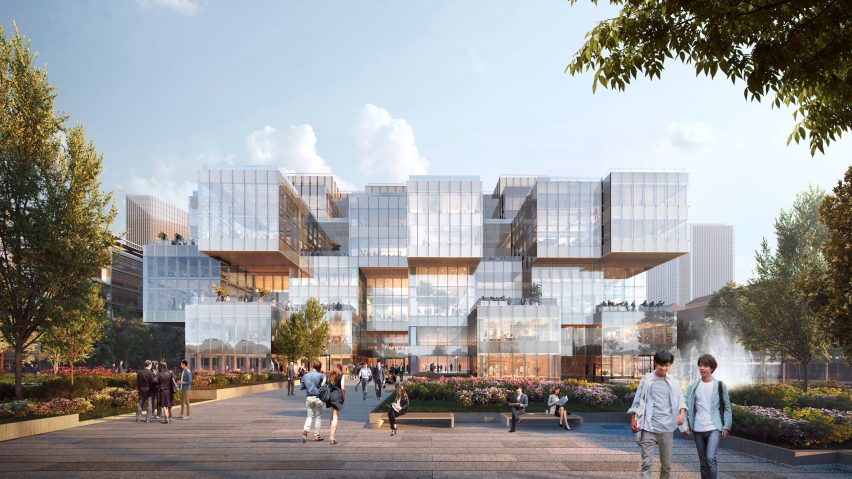Architecture studio Skidmore, Owings & Merrill has revealed its design for a headquarters for global technology company Alibaba in Shanghai's Xuhui District.
The 75,000 square-metre building will consist of a group of cuboid-shaped modules containing office spaces arranged in a form that Skidmore, Owings & Merrill (SOM) likens to a cloud.
"Pushing and pulling the interior spaces of the headquarters creates terraces and cantilevered meeting areas that blur the distinction between indoors and outdoors and result in an indeterminate, cloud-like form," said SOM design partner Scott Duncan.
"[This symbolises] both Alibaba's extraordinary digital presence in the Cloud, as well as the technology industry's shifting skies of innovation," he told Dezeen.
To accommodate the company's growing team, the structure was designed to be as flexible as possible, with column-free interiors that can evolve with the company's needs.
"'The only constant is change' is one of Alibaba's guiding principles," said Duncan. "We took this ethos to heart, designing a workplace capable of evolving and adapting to new needs, teams, and technologies over time."
"It changes based on immediate user-driven inputs — by the hour and by the second — but is also composed of a mosaic of carefully calibrated modules that allows teams to morph and evolve over the near and long term," he continued.
The building will comprise indoor and outdoor workspaces surrounding a courtyard. Around the building's perimeter, meeting spaces open out onto outdoor terraces that offer access to nature and views of the city's Huangpu River.
Communicating stairs and bridges between the spaces encourage people working in different areas of the headquarters to connect with each other.
Around the structure, outdoor spaces contain sheltered seating and areas of greenery, which the studio hopes will be beneficial to employees.
"Smart technology infrastructure and biophilic design features will further enhance employee wellness, including natural ventilation, terraces, and green roofs," the studio commented.
"Users will have the ability to control their environment, opting in for things like natural ventilation, fine-tuning the amount of daylighting via a smart shading system, or adjusting artificial lighting levels at their desks based on their personal preference," Duncan added.
According to SOM, Alibaba's Shanghai headquarters will target both low embodied and operational carbon. The studio has aimed for the design to exceed the requirements for LEED v4 and China Green Star. Roof gardens will harvest rainwater and smart systems will cycle fresh air, reducing the need for cooling.
The facade has been designed to redirect up to 40 per cent of solar heat gain, along with minimising glare and wind tunnels. An AI-controlled shading system will allow for temperature moderation by responding to the sun's movement.
"The structural system is primarily steel to allow for high levels of off-site prefabrication and reduction of waste," said design partner Duncan.
"The dynamic glass is unique in that the shades have been engineered to work as an integral part of the building's thermal comfort system – a truly smart skin that will get smarter as the building learns over time."
Founded in 1939, American firm SOM is one of the largest architecture studios in the world. It recently created a mass-timber office for the UN, along with unveiling plans for the renovation of a 1950s skyscraper in New York.
The renders are courtesy of Skidmore, Owings & Merrill.
Dezeen is on WeChat!
Click here to read the Chinese version of this article on Dezeen's official WeChat account, where we publish daily architecture and design news and projects in Simplified Chinese.

